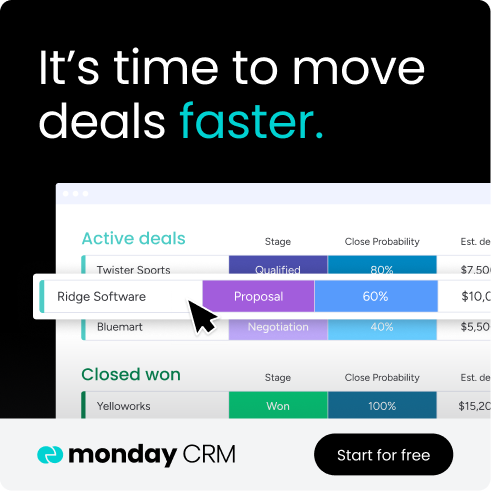If you’re marketing to everyone, you’re essentially marketing to no one. Without a targeted approach to understanding your intended audience, your sales team will find it challenging to wade through the crowds and sell to the right buyers. This is where sales prospecting comes in.
Prospecting in sales sets you up for success by vetting the right people before you start actively selling to them. Think of it as doing deep research into your intended audience and then picking out a selection of prospective candidates who are most likely to buy.
In this guide, we’ll cover everything you need to know about sales prospecting, including understanding the different types, taking the right steps to ensure success, where AI fits into it all, and how platforms like monday CRM can help you tie it all together.
What is sales prospecting?
Sales prospecting is a strategy focused on expanding your customer base by identifying potential sales contacts, known as leads, and warming them up into sales opportunities, known as prospects. Usually, sales prospecting is carried out by business or sales development representatives.
The goal of sales prospecting is to ensure a steady pipeline of new business by initiating and developing relationships with targeted prospects.
If your team is giving a sales pitch to just anyone, then they’re likely wasting their time. Sales prospecting ensures when teams are pitching, they’re in front of an audience that’s most likely to buy, setting them up for success from the get-go.
Stages of sales prospecting
There are different stages to sales prospecting for a lead to turn into a prospect, but all of them take place before any selling begins. Here’s a brief overview of the stages of sales prospecting:
Stage 1: Locate prospect
Find sales leads that are likely to be interested in your product or service using lead gen software or sales prospecting tools
Stage 2: Start a conversation
Sales teams must initiate contact and build rapport with leads
Stage 3: Qualify prospect
Qualify leads by asking questions to understand their needs and pain points, budget, timeline, and decision-making process
Stage 4: Position product as a solution
Sales reps need to plant the seed of how their product or service can solve a prospect’s needs
What are the different types of prospecting in sales?
Traditionally, sales prospecting is associated with cold calling, which was a popular way to gather and qualify leads before the digital age. However, we’ve come a long way from cold calling days and now have different ways to prospect sales.
Oftentimes, sales prospects come to a company rather than a sales rep seeking them out. It’s important to distinguish between two overall types of sales prospecting: inbound and outbound.
- Inbound prospecting uses targeted content and marketing materials to generate leads and attract consumers to your company
- Outbound prospecting is more proactive and relies on a sales professional actively and directly seeking out potential leads
Within outbound prospecting, there are different ways to go about securing leads. Here are a few different types of prospecting techniques sales reps use:
- Cold emailing: If you get the email address of a potential buyer who fits the bill, sales reps can send an initial cold email before any other interaction to try and book a call, meeting, or gather more information
- Phone prospecting: Unlike cold calling, which has a straight-to-voicemail rate of 80 to 90%, modern phone prospecting involves reaching out to potential leads who have shown interest, either through a lead generation form, messaging, or another avenue
- Video prospecting: 86% of marketers say that video has helped them generate leads, and it can work great when you’re sending prospects invitations for video calls or pre-recorded demos that introduce your product
- Social selling: Expand your brand’s reach by building an online presence on sites like LinkedIn, where you can post relevant information about your product, answer questions, send messages, and connect with potential customers
- Networking: Engage in face-to-face conversations at industry networking events, conferences, and trade shows to meet prospects and collect contact information to follow up with them via phone, email, or a video call to further discuss a sales opportunity
- Referrals: When sales reps have a good relationship with existing clients or partners, they can leverage the connection to get introduced to new potential customers
Why is sales prospecting important?
The average American sees between 4,000 to 10,000 ads every day. That’s a lot of noise and competition for sales teams to cut through to convert leads into paying customers. Enter sales prospecting: a technique that puts sales reps in the best position to sell through researching potential customers, building relationships with them, and understanding their pain points. The benefits of effective prospecting mean you can:
Constantly feed your sales funnel
The sales process can grind to a halt without a pipeline of qualified prospects to work with. The right prospecting strategy will focus on quality and quantity leads, making your monthly, quarterly, or annual sales targets a breeze.
Get in front of your ideal customer
Sales prospecting allows you to be more intentional with your sales process. Prospecting generates sales leads who fit your ideal customer profile, giving sales reps control over how they put time and resources into closing. You’ll be better equipped to screen out leads who are unlikely to buy and zone in on the more probable customers.
Establish a relationship with the prospect
By going through sales prospecting techniques, such as gathering data to support nurturing leads, sales teams can learn a lot more about their potential customers. Armed with this information, it will be a lot easier for sales reps to build rapport and establish trust.
Increase revenue
Consistency is everything in sales, so a strategic approach is critical in generating regular sales leads and having the knowledge and experience to close those leads. The outcome is more sales, more revenue, and more profits.
Create scalable processes
With specific sales prospecting strategies, your team can build processes that they can use over and over again. This makes it easy to repeat and scale these processes, especially when onboarding new sales reps.
Collect data to inform future sales strategies
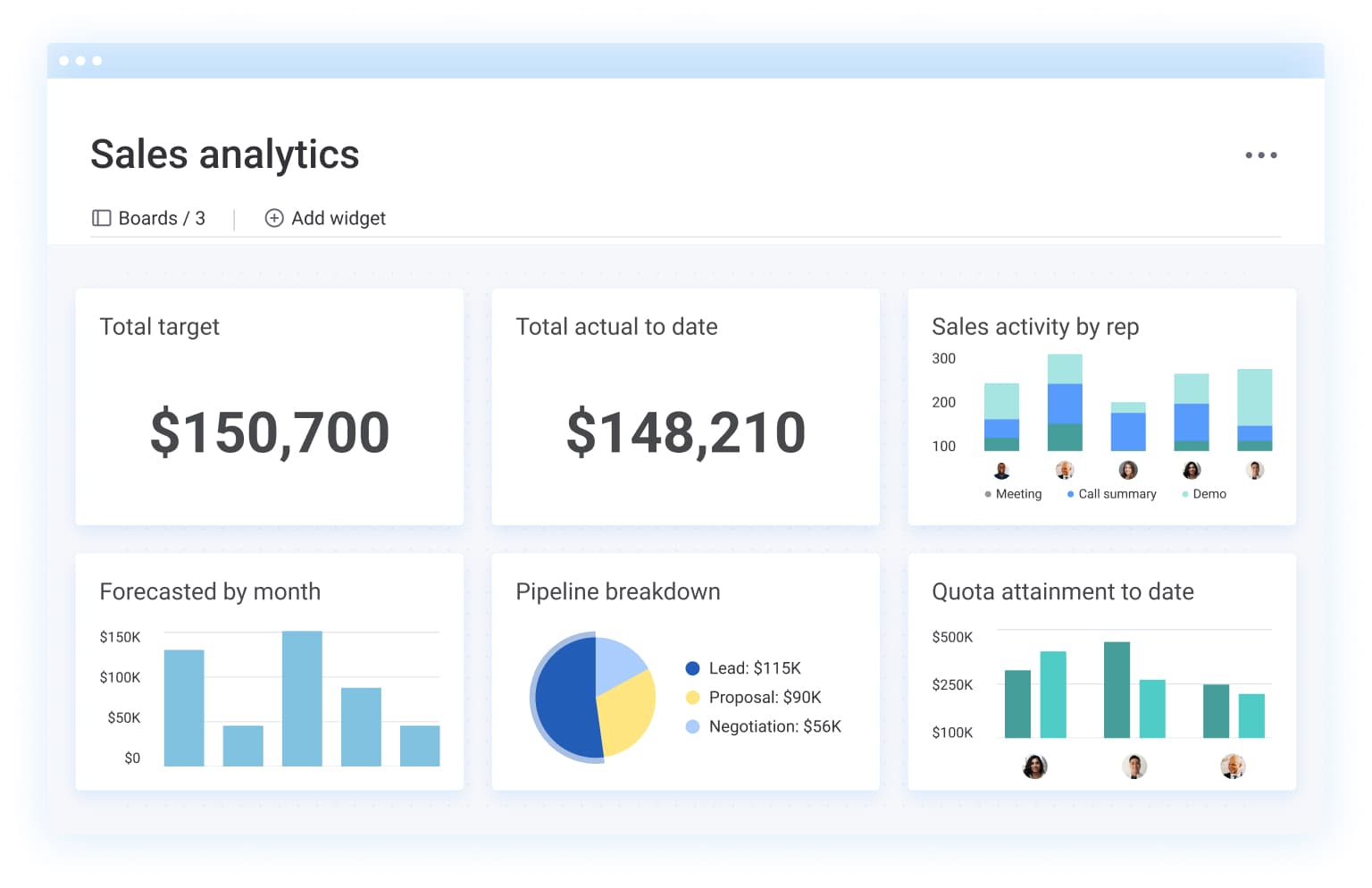
Sales reps can make data-driven decisions in future sales strategies. You can learn more about the best lead source for maximum sales success or gather data for your product development team about new pain points in the market. Using a sales CRM like monday CRM allows you to handle the store, analyze, and share relevant data with your teams to boost sales cycle productivity and gain an instant overview of your future sales pipeline.
Try monday CRMB2B vs B2C sales prospecting
We looked at different types of sales prospecting strategies above, and most of them were focused on outbound strategies. Most B2B companies will use outbound prospecting strategies since they’re more accepted in the business world. Things like cold calls and sales emails from one company to another are more likely to be answered than to individual customers.
For B2C sales prospecting, it’s more common for sales reps to rely on inbound strategies since at least that way they already know that a customer is interested in learning more about a product or service.
Sales prospecting tips and best practices
The best way to make sure your sales prospecting process is a success is to tailor your strategies to your business. Try a few different strategies to see what works best for leads and your product, and then focus on those to create a repeatable procedure. Use one or a combination of the tips below to make sure you’re employing effective prospecting strategies.
1. Define your buyer persona
Sales reps must know their target audience to tailor sales messages, content, and product development to their needs. Before you begin sales prospecting, map these granular details out, including your buyer persona’s location, company size, and industry.
2. Research your prospect
Conduct research into your most promising prospects. You want to understand their role in organizational purchasing decisions and learn whether or not they have buying power or if they hold any influence over a direct manager or someone else who does.
3. Learn your prospects’ pain points
Discovery phone calls are a chance to listen to your sales leads and uncover their challenges. Ask the right questions and reflect before responding with how your product or service solves the biggest problems.
4. Be aware of sales triggers
Sales reps should always be aware of sales triggers for their industry, such as prospect promotions, upcoming trade shows, or corporate mergers. These are prime opportunities for sales prospecting as companies may be interested in new solutions as part of a new digital transformation strategy.
5. Continue to build brand awareness
The more you expose potential sales leads to your brand and product, the more likely they will recognize it during sales prospecting. Consider branching out on social media platforms to become known as a trusted leader in your space and automatically draw prospects toward your expertise.
6. Always follow up on your sales prospecting
Selling isn’t easy, but persistence is key. You want to make sure you’re following up on messages and calls, but you also want to be aware you’re not being overly pushy. If you’re not progressing a relationship after several attempts, start working on other prospects in the company who might be more receptive to your engagement.
7. Use storytelling
Stories are a powerful way to forge human connections. When sales teams do this well, they create a story that speaks to a prospect’s emotional desires. This can be something as simple as a sales rep telling a story about how their product solved the same pain point for other customers.
Try monday CRMAutomation and AI for sales prospecting
New artificial intelligence (AI) tools are making it easier and quicker for sales reps to find and nurture prospects. There are many ways sales teams can apply AI technologies to enhance their sales prospecting strategies, freeing up more time for sales agents to focus on building personal rapport with potential clients. Here are just a few ways AI is changing sales prospecting:
- Use AI to trigger automated follow-ups by email or another messaging channel to nudge a potential prospect when they haven’t replied
- Create personalized content with generative AI to send assets like emails, brochures, and presentations using relevant data points that prospects will relate to
- Generate personalized emails with AI to make cold emailing quicker and more customized
- Score incoming leads using AI to make it easier to automate prioritization so sales reps can instantly see which prospects to focus on
- Access predictive analytics tools to assess data on leads and identify the most promising ones
- Chatbots and conversational AI can help with incoming prospecting by scheduling sales meetings and qualifying prospects in the early stages
A modern sales intelligence platform or a customer relationship management (CRM) software like monday CRM can provide businesses with advanced AI and automation features. With a platform like a CRM, sales teams can work towards a common business goal while keeping track of every prospective customer and focusing their sales efforts on the ones that matter most.
How do you measure sales prospecting success?
There are a lot of different ways teams can track prospecting success, including different metrics that can be used to track progress. Some of the metrics companies can track include:
- Conversion rate
- Activity metrics such as calls or emails per day
- Sales Qualified Leads (SQLs) generated
- Booked meetings
- Response rate to outreach by email or phone
To accurately measure your sales prospecting rates, you can also divide your acquired leads by the prospects you contacted and then multiply by 100.
For example, if your sales teams contacted had 200 leads this month, narrowed down the list of prospective clients to 100, and then contacted 50, you’d have a sales prospecting rate of 25%.
As a general rule, sales prospecting software can help you organize and measure all your prospecting efforts, for better results every quarter.
Enrich your sales prospecting with monday CRM
If you’re looking for a flexible and intuitive way to manage your sales cycles, then monday CRM is the solution that sales teams love to use. As a fully customizable platform that provides robust capabilities to handle complex workflows with an intuitive, easy-to-use platform, monday CRM can handle your team’s sales prospecting needs.
Packed with AI features that make it ideal for automating prospecting messaging and boosting productivity, monday CRM empowers teams to work smarter without working harder. Sales teams can rely on monday CRM to work collaboratively towards a common business goal while successfully dividing workloads to focus on nurturing prospective clients.
Let’s take a closer look at some of monday CRM’s sales prospecting features.
Customizable dashboards
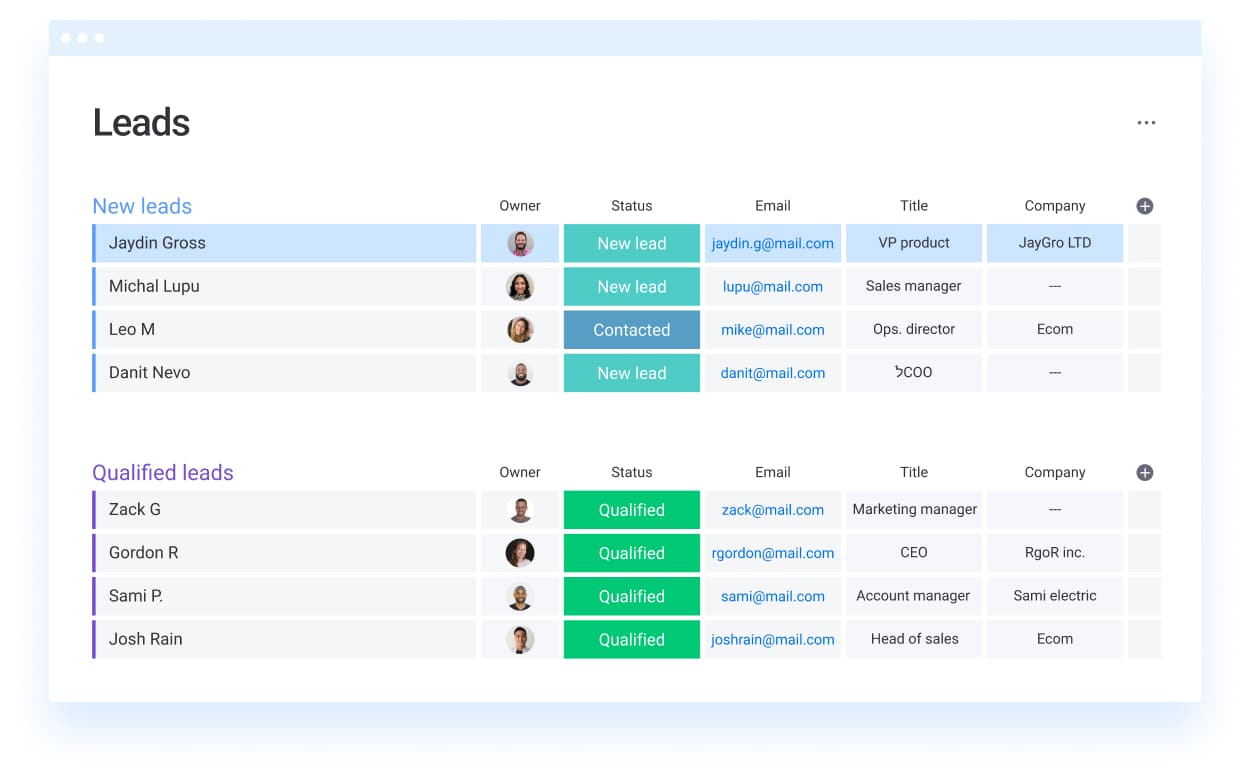
Add the columns you need to your boards, from expected revenue to team performance, critical files, docs, and more. Choose from 27 different work views such as Calendar, Timeline, Table, Chart, and others, and switch between views as needed.
200+ app integrations
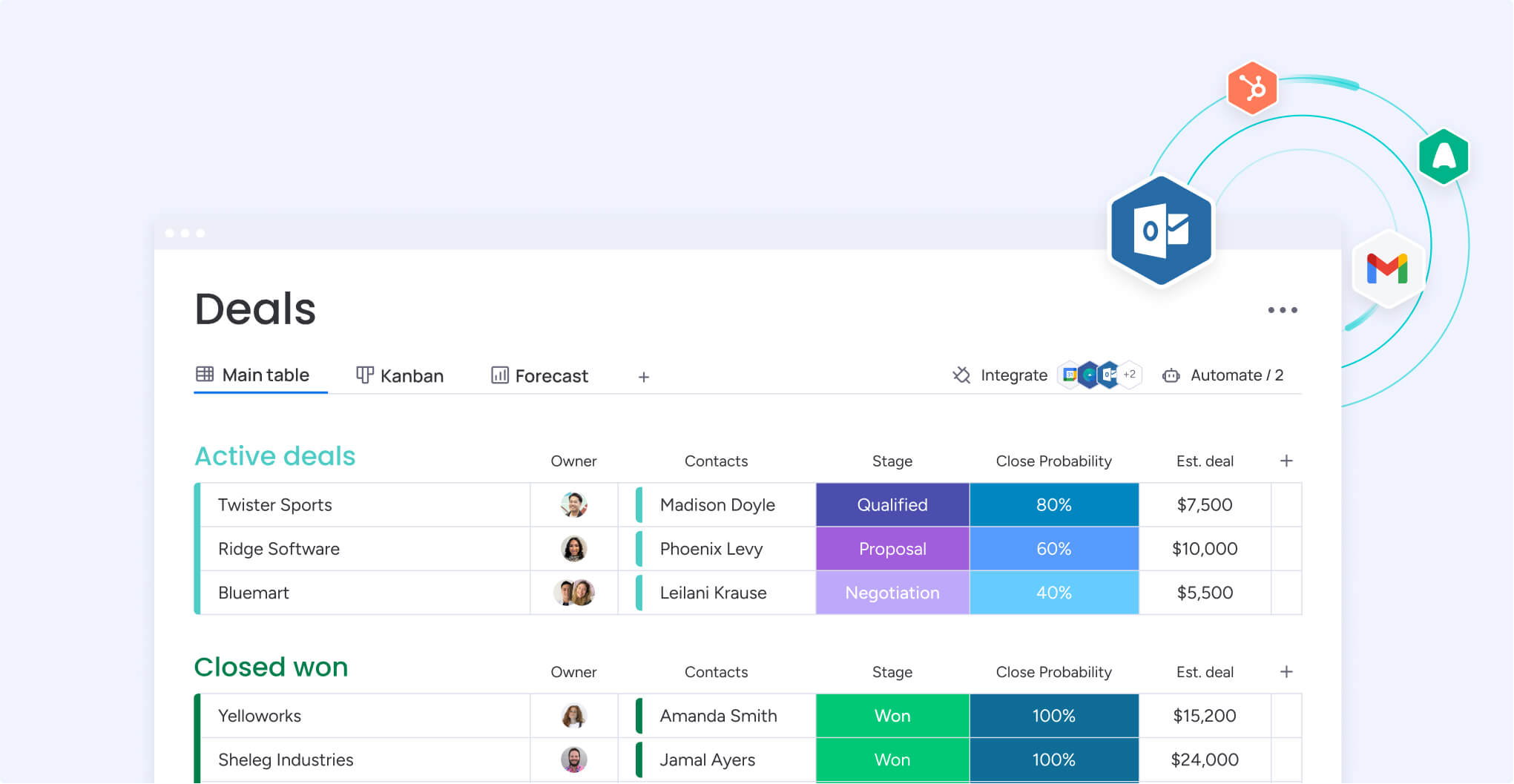
Connect monday CRM with your favorite sales tools like Slack, LinkedIn, Excel, or Google Drive to provide seamless communication and messaging. Trigger workflows and synchronize data across applications so that you’re always notified when there’s an update with a lead or prospect.
AI-powered automation tools
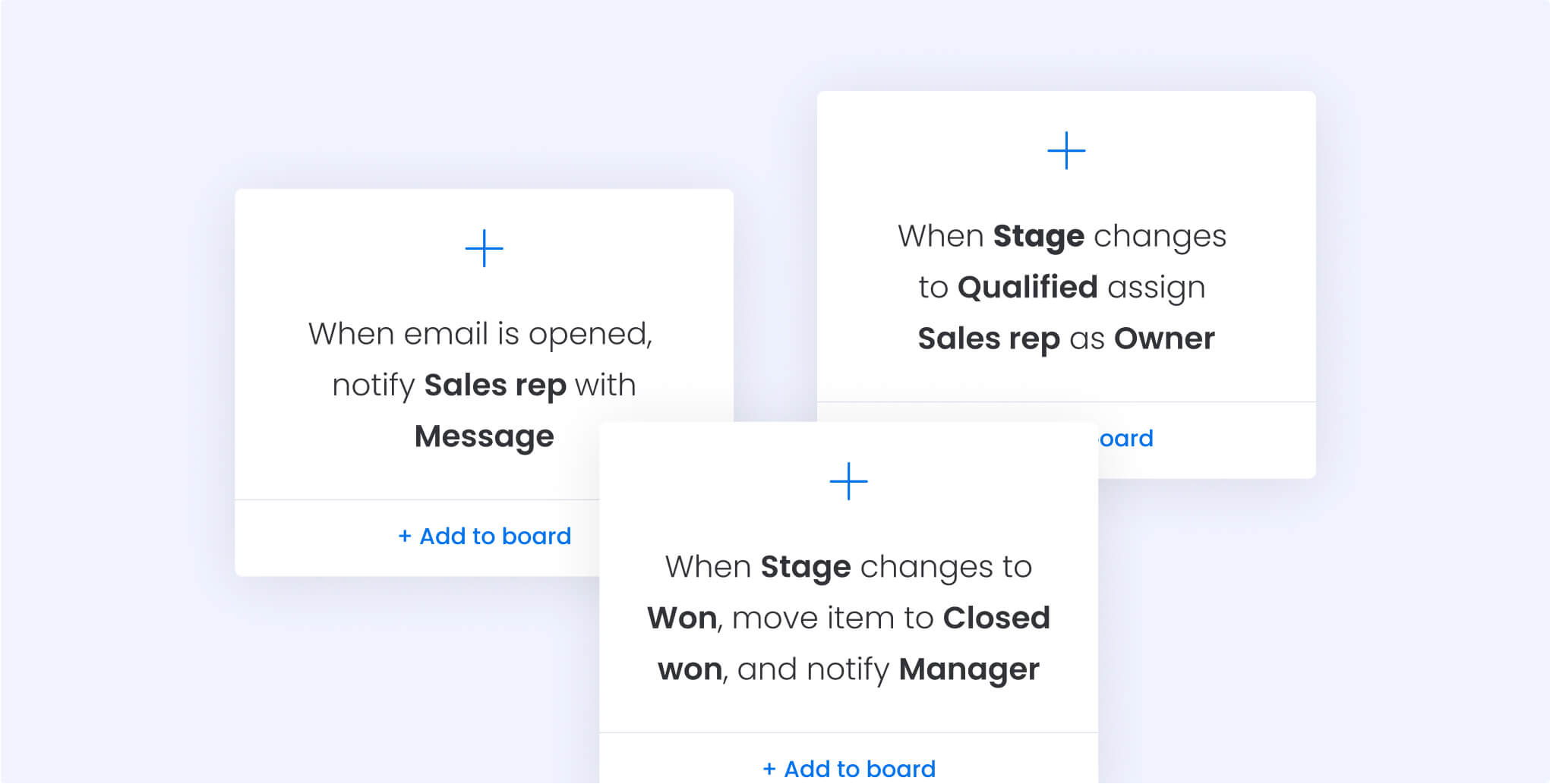
monday CRM uses AI to power no-code automations, meaning you can set up automated workflows in just a few clicks. AI can help sales reps with a range of activities, from generating call summaries to scoring incoming leads and even writing emails, making sales prospecting processes less time-consuming and more productive.
Lead scoring
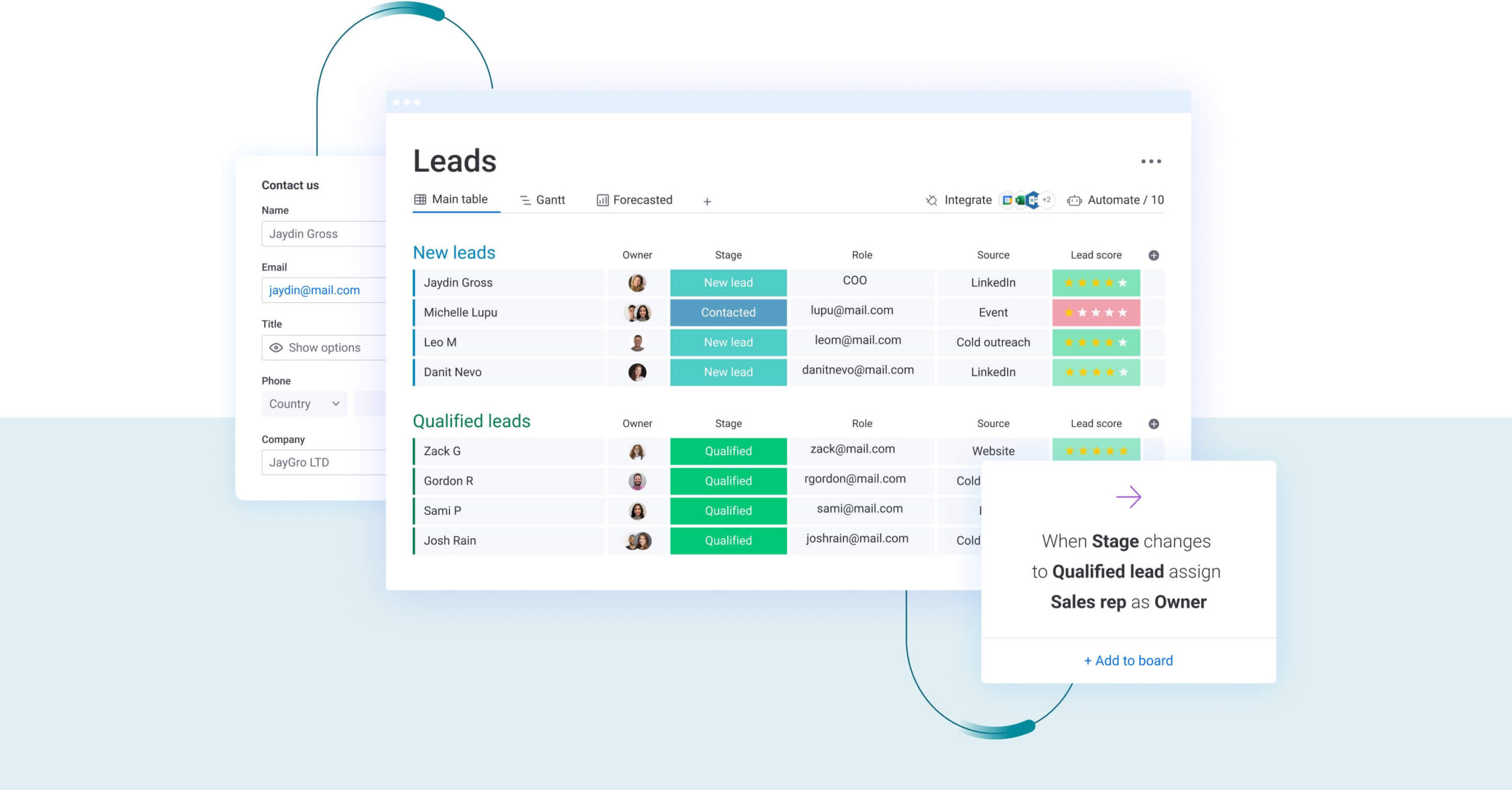
Score incoming leads and add visual cues on your boards to instantly see which potential customers to focus on. To save time, you can set custom criteria and parameters to automatically score new leads.
Try monday CRM
Prospecting in sales allows you to nurture those leads and turn the best ones into paying customers that will drive revenue for your company. For greater success, hook your sales teams up with the right CRM tool, like monday CRM, to boost your prospecting efforts with AI-led automation and gain clarity on your sales pipeline.
FAQs
What is prospecting in sales?
Prospecting is the sales process of identifying potential sales leads, researching their organization, and determining whether they have a need that aligns with your product or service.
How can you move prospects through the sales cycle?
The sales pipeline consists of six stages: prospecting, nurturing, qualifying, product demo, proposal, and closing. To move prospects through the sales cycle, sales reps should make sure they’re dealing with a decision-maker, and ensure their product or service aligns with the prospect’s specific pain points. From here, it should be an open goal to position your offering as the solution and close the sale.
Which CRM options assist with sales prospecting?
Many CRMs on the market can help sales teams with prospecting. When considering different software options, it’s important to select a platform that’s both flexible and equipped with the right features to scale as your team grows. monday CRM includes tons of features that can assist with sales prospecting and has a straightforward interface that makes onboarding a breeze.
What is an example of a sales prospect?
A sales prospect goes a step beyond a lead and is someone who has shown interest in getting more information about your product or service. For example, an individual or business who downloads a white paper or attends a webinar.
What is a SQL and how is it important?
A sales qualified lead, or SQL, is a prospect who has been vetted and has a high likelihood of turning into a customer. They might show clear buying intent that makes them a prime candidate for focused sales prospecting efforts.
 Get started
Get started 


